My HOKA Speedgoat review digs into the new HOKA Speedgoat 6 trail running shoe. The latest version of the best-selling trail runner in the USA has garnered mixed reviews among runners. As a hiker, I was stoked to snag a pair and personally put it through the ringer on a series of test hikes in New Mexico. My first-hand review of the new Speedgoat 6 compares it to previous Speedgoats and evaluates its support, weight, fit, comfort, weather protection, traction, and overall value for hikers.

Testing the HOKA Speedgoat 6 at Tres Pistoles Trail, New Mexico
HOKA Speedgoat 6: What's New?
New in 2024, the HOKA Speedgoat 6 includes several updates compared to the Speedgoat 5 and older Goats, including
HOKA made these changes in response to customer feedback on the Speedgoat 5. However, some customers still aren't happy that HOKA tweaked the Goat. Do the negative reviews have some substance? Or is this the typical over-reaction that happens every time a company updates one of its signature shoes?
Speedgoat 6 vs Speedgoat 4
As part of my HOKA Speedgoat 6 review, I did a side-by comparison to find out.
LiteraIly.
I still own the old Speedgoat 4—arguably the most popular version of the shoe. So I did a couple of test hikes with the new Speedgoat 6 on one foot and the old Speedgoat 4 on the other. Only one hiker laughed at me for wearing mismatched shoes as I hiked up and down the 9 mile, 3000+ foot Pino Trail in New Mexico to compare these two Speedgoats side by side.

Speedgoat 4 (blue) vs Speedgoat 6 (gray)
The biggest take-away is that I mostly forgot I was wearing two different shoes.
I initially noticed a slight difference as I walked the paved road to my trailhead. The Speedgoat 4 was softer and cushier on that hard-packed surface. However, once I actually hit the trail, I rarely felt any difference between my left foot (Speedgoat 6) and right foot (Speedgoat 4). On the steepest descents, the Speedgoat 6 seemed to have a more secure fit and slightly better traction—something I wouldn't have noticed without concentrating solely on my feet.
In short, the Speedgoat 6 is still a Speedgoat and—and still one of the best trail running shoes for hiking.
HOKA Speedgoat 6 review
My review of the new HOKA Speedgoat 6 is based on more than 100 miles of day hiking in New Mexico's Sandia Mountains and Sangre de Cristo Mountains. The mix of steep and rocky trails, canyons, washes, woods, and high alpine peaks provides a great testing ground to figure out where shoes excel and fall short. As always, my reviews are 100% independent and based on my first-hand hiking experience. A HOKA rep graciously provided me with a demo pair to review with the understanding that I would subject the Speedgoat 6 to strenuous test hikes and publish my honest opinion of the shoe's pros and cons.

Support
The main reason to hike in Hokas is comfort. But the Speedgoat 6 is more supportive than you might think. Its thick stack of foam adds lateral stability for my ankles and limits how much my feet flex over rocks and uneven footing. The lighter yet firmer foam in the Speedgoat 6 seems to have upped the support—it almost wears like a "hiking shoe" (not "running shoe") in spite of its light weight. My feet have felt fresh after several hikes on rocky trails with 3000+ feet of elevation gain. With more than 500 miles in Speedgoats the past few years, I've never turned my ankles over. I have lower-body issues, and this is one trail running shoe that works for my feet and ankles.
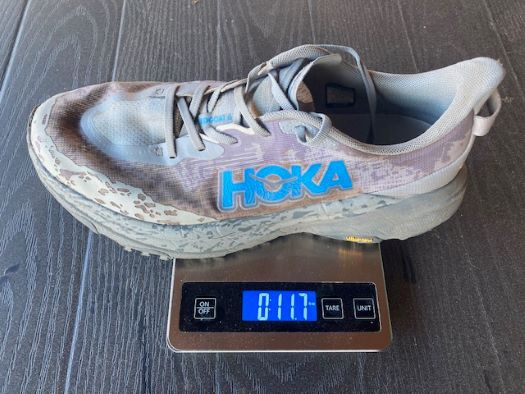
Weight
Even though the Speedgoat 6 is sturdier than its predecessors with thicker midsoles, it's somehow even lighter!? My men's size 12-wide weighs less than 12 ounces per shoe. That's among the lighter trail running shoes I recommend for hikers. Compared to my other max cushion trail runners, the Speedgoat 6 is half an ounce heavier than the Topo Ultraventure, the same weight as my Salomon Ultra Glides, and a half-ounce lighter than my Salomon Thundercrosses. If you value weight savings, the HOKA Speedgoat 6 is a trail runner hikers should consider.

Fit
The Speedgoat runs true to size with a standard fit. Most hikers will want to size up 1/2 size over their everyday shoe size. In my personal experience, the older Speedgoats had a slightly "roomy" fit, but the 6th Speedgoat features form-fitting uppers for a comparatively snug and secure fit. I don't believe the last/sizing actually has changed—my old and new Goats measure exactly the same. Still, the new, snug-fitting uppers give the sensation of a narrower fit. The men's 12-wide still fits me well, but it doesn't feel as forgiving or as roomy as my previous Speedgoats.
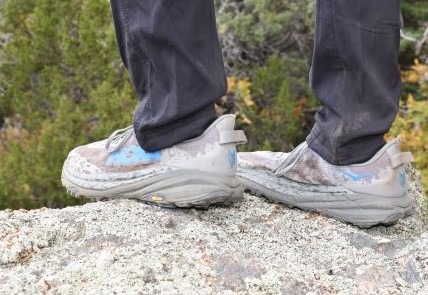
Comfort
For years, the HOKA Speedgoat cornered the market on max cushion trail running shoes with tall stacks of heavenly foam. The Speedgoat 6 actually has a taller stack height (more EVA foam) than older Speedgoats. However, the new, more responsive foam actually feels firmer. There's still plenty of shock absorption. But the Speedgoat 6 isn't as soft and squishy as some of my other Hokas.
For hikers, that's not necessarily a bad thing. Firmer foam increases the shoe's support and durability. But it potentially compromises HOKA's calling card—copious cushioning.
Personally, I still find the Speedgoat 6 a comfortable shoe. I've hiked comfortably on several steep trails with 2,000-3,000 feet of ups and downs, including the La Luz Trail, Pino Trail, and Tres Pistoles Trail outside of Albuquerque. However, less luscious foam opens the door for comfort-oriented hikers to flirt with other max-cushion trail shoes with softer landings, such as the Topo Athletic Ultraventure 3, Salomon Ultra Glide 2, and Salomon Thundercross.

Weather Protection
Now that I live in a semi-arid environment, I stick to non-waterproof trail running shoes since they don't run as warm. That's been a solid choice in the high desert that I now call home. However, the Speedgoat GTX offers hikers GORE-TEX waterproofing and breathability. In my experience, GORE still provides the most reliable and breathable waterproofing. (And yes, shoes can be both waterproof and breathable.) Just keep in mind that trail runners only provide a couple inches of water protection—though HOKA's extra-thick foam gives a little more water clearance than the average trail running shoe.

Traction
Traction is another plus since HOKA decked out the Speedgoat 6 with Vibram Mega Grip outsoles. This tread digs into the weathered granite trails in my area and seems to handle most trail conditions—I have well over 1,000 miles of personal experience with this specific Vibram outsole (which several brands use). I have scrambled up some bouldery washes in the Speedgoat 6 (see pic) but its climb-ability is only good up until a point—the lugs aren't wide enough or soft enough really to smear on smoother rock surfaces. The traction profiles best on moderate to steep terrain with loose sediment.

Value
The Speedgoat 6 has a MSRP of $155 (regular) and $170 (GORE-TEX). That's near the top of my list of the Top 10 trail runners for hikers. For comparison, the Salomon Thundercross costs $140 and the Topo Traverse $150. Its durability is good (by trail runner standards), and it's packed with premium features, such as Vibram Megagrip outsoles, optional GORE-TEX waterproofing, and an excellent weight : support ratio. Still, it's not cheap.


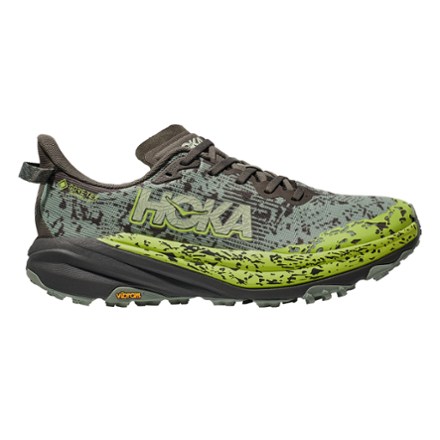



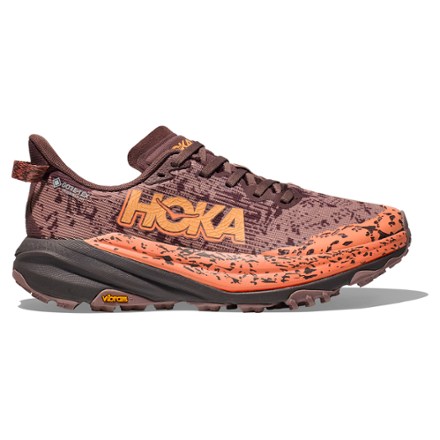
This post includes affiliate links, including the buttons above. If you click on these links and buy something, the retailer may share a small percentage of the sale with Hiking Feet—at no cost to you. That's a free and easy way for you to support this site's free and independent content.
HOKA Speedgoat 6: Pros vs. Cons
My HOKA Speedgoat 6 review has concluded that the new Speedgoat 6 is still a Speedgoat. As noted above, I had to strain to notice subtle differences in a side by side test with the popular Speedgoat 4. Still, some of the tweaks to this shoe's cushioning and uppers may alienate long-term Speedgoat fans. The feel is a little bit different. Overall, this shoe's pros and cons are similar to my reviews of older HOKA Speedgoats:
Conclusion:
If you're hiker, the HOKA Speedgoat 6 should be on your short list of trail running shoes to consider. It's a supportive shoe with clutch traction and a thick layer of shock-absorbing cushioning. With its firmer, more responsive foam, the Speedgoat 6 sometimes feels like a hiking shoe (not a running shoe)—even though it's much, much lighter than the best hiking shoes.
At the same time, it's not as soft underfoot as it used to be. And more brands have jumped into the max cushion category, too. So comfort-oriented hikers who love them some cushion might consider the growing selection of max cushion trail running shoes that I recommend for hikers. The HOKA Speedgoat now has competition for the title of King or Queen of Cush.
Overall, I personally recommend the HOKA Speedgoat to ultralight backpackers and day hikers who want a shock-absorbing trail running shoe that balances support with weight savings and delivers clutch traction on moderate to tough trails.
Best Fit
standard feet
wide sizes available
Best Match
day hikers, ultralight backpackers, thru-hikers
If you're not sold on the newest Speedgoat, please browse Hiking Feet's footwear reviews and recommendations for the best trail running shoes for hikers. If you are feeling the Goat, please consider purchasing them through the affiliate links above. That's free for you—and sends a few bucks my way to run this site, buy boots and shoes to review, and pay part of my rent.
Thanks for supporting Hiking Feet. Happy Hiking!
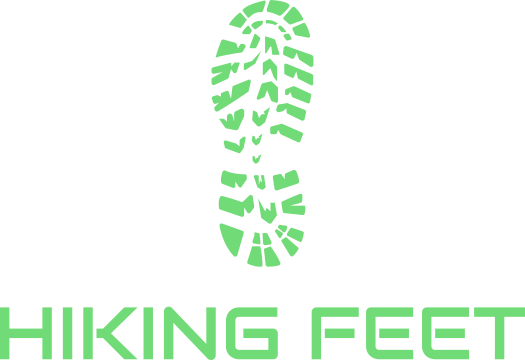
Comments are closed.